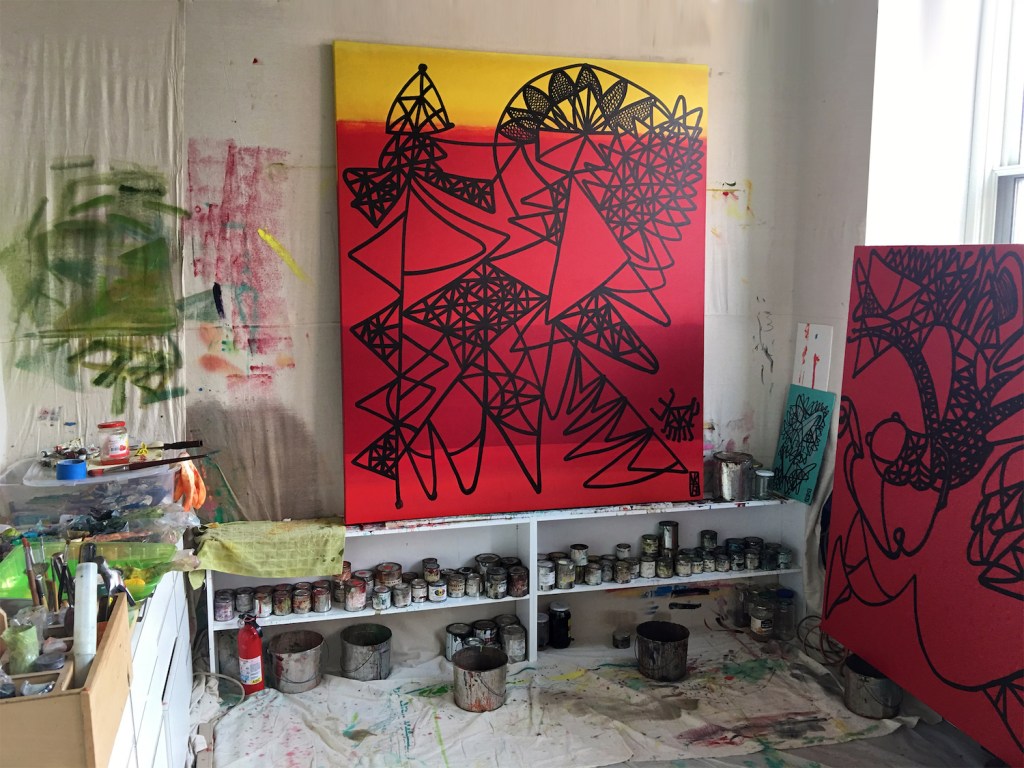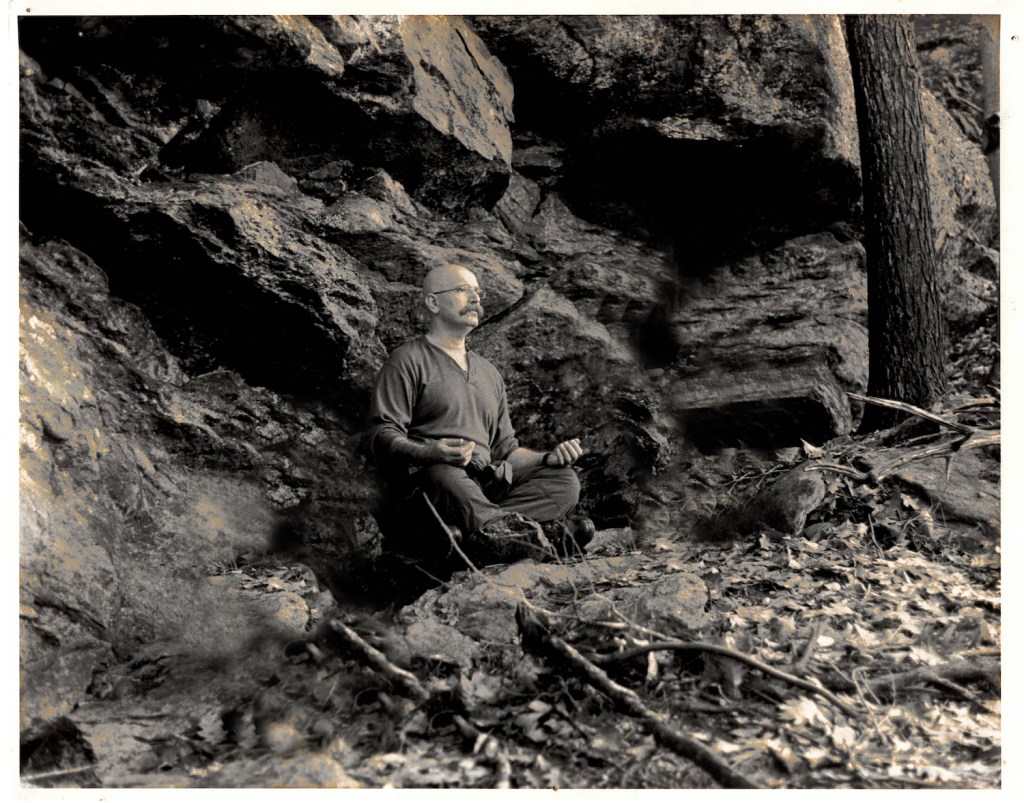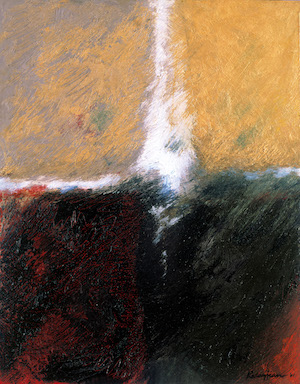by Anna K. Gargarian
With “Heart Flow: Spiritual Abstractions” opening in just a few days, I took a moment to sit down with artist Vazken Kalayjian to discuss his practice – both artistic and spiritual, as for him they are one and the same. The below interview is an informal dialogue between artist and curator, as we think about materials, rites of passage, heightened states of consciousness, and how that translates into artistic practice.

Anna K. Gargarian: Tell me a little bit about your process
Vazken Kalayjian: Well, it’s always a long preparation to start a work – mentally, physically, spiritually. And it’s always after some intense experience. Like I’ve gone on a Vision Quest, or had an interesting meditation, or I’ve visited a special place, whether it’s in nature or a temple, or whatever. And that experience calls me to start.
Usually I’ll work on several canvases at once within the same theme, or series. Because I like to use thickly applied oil paint. I like the intensity of real pigment and that makes it dry slower. So because of that, I’ve learned that it’s always good to have a few pieces going at once (as many as I can fit in my studio). So I’ll do an underlayer on one canvas, and then move onto the other, then I’ll come back to it a few days later. I kind of go back and forth until eventually one piece gets to a particular place where I feel like it’s almost complete. Then I turn the other works around, and focus on that piece until it’s finished. I may go back to it, but usually I don’t. Then I continue with the other works in a similar fashion. So that’s the process….

The thing about paper, and what I love about Arches paper in particular, is that it’s very thick. It’s 100% cotton, so it absorbs the paint quickly and I can finish a piece in a day or so. With canvas it takes more time. I usually work on a linen canvas, and because I like to work really roughly on the surface (you can see all the writing and scratching and claw marks), I double stretch the canvas and back it with Sintra board to keep a hard surface, all of which slows the drying process even further.
I’ve experimented with a lot of different materials. My canvas maker back in New York was Simon Liu, he was a famous canvas maker who worked for artists like Rauschenberg and Jasper Jones, and with the Metropolitan Museum of Art. And he made Aluminum panels for me, that was Rauschenberg’s favorite. From an archival perspective that’s really indestructible. I like thinking of the afterlife of a work, and part of that is being responsible with the materials I pick. I’m not into the gimmicky stuff with deteriorating art pieces, like a rotting banana, or whatever.
AKG: Tell me a bit about the Bridgeport Rhapsody series. It’s very different from the other series in this show. Why the name “Rhapsody”?
VK: Well…it has a musical connotation. When I first moved to Bridgeport from Westport – Westport is a very upper middle class and gentrified town. In Bridgeport I was at the Read’s Art Space, where all of the residents are artists. So my neighbors were musicians, painters, writers, culinary and theatre experts, and we’d get together over wine, we’d play music, look at art – so there was all of this exchange. And then from my window…instead of looking at these very manicured suburban lawns, I was looking at graffiti and could hear musicians, or rap music. You know… it was inner city. It reminded me of my Brooklyn days as a student. Not the Brooklyn of today, I’m talking about the Brooklyn of the 70s. Even though physically Bridgeport is only 20 minutes away from Westport and Greenwich – I mean, literally they share the same air and beach and highway – but you have this huge contrast. Most noticeably in terms of ethnicity, but also in terms of soul. It was really great. It’s like I went from soullessness to someplace soulful, with rhythm and colors and tastes. And so you have this mix. I mean you have the rap, the seagulls, the wind, jazz…all of that together, all of these sounds – it was really a beautiful experience to go through. Almost like an awakening. I was living in a kind of bubble before – of affluence….of….well these towns, intentionally they keep others out. So when you extricate yourself from that, you have this whole new experience….it’s beautiful.


AKG: So your periods of creativity, they don’t just follow some kind of spiritual experience. It’s also these big life changes?
VK: Well you know, a lot of people think that spiritual experiences are peaceful. Or somehow it’s relaxing…not necessarily. Sometimes when I go out on a Vision Quest, it’s really difficult, it’s painful, it’s scary…you have all sorts of experiences. It’s not always blissful. It’s not that image we think of, sitting crossed-legged by the ocean.…
AKG: Could you explain what you mean by a Vision Quest?
VK: The Vision Quest as we know it in the states comes from the Native American tradition. It’s basically an experience you have when you’re going through any major change in your life, some rite of passage, or maybe you want to honor certain cycles… so you chose to take time away from everyday life and you isolate yourself in nature where you can’t be disturbed by anyone. Away from civilization into the wild. It could be anywhere from 4 days, 11 days, 28 days or 40 days. You stay in one place. You don’t bring anything with you – no reading, no sketch books, no iPhone or music. Nothing distracting. Part of the time you fast, depending on your health. And then you spend your time alternating between meditation and doing Tai Chi, Chi Gong, chanting and prayers, all sorts of practices to replenish your energy. And you do it all in one place, within your circle. Traditionally, you also go through 4 days without sleep – which is really difficult. And during this time you’re basically shedding. You’re cleansing and shedding – dealing with everything that comes up. Whether it’s the cold of the night time, or the heat of the day time. Whether it’s insects or animals that show up and confront you… you deal with boredom, you deal with sadness, and all sorts of things that you have that you’re shedding. I’ve been doing this yearly since 1992.

AKG: In previous conversations you told me that when you work you’re really in a flow-state, which you achieve usually through your spiritual practice. But how do you reconcile being in a fully immersed flow-state, with working on an art piece for an extended period of time? How do you work in flow state, then interrupt it with your daily life, and then come back to it….how does that fit into your process?
VK: That’s a good question. It’s not really interrupting. You see, in my early years when I was doing zen meditation, it was very much like that. I would work during the day, then in the evening I’d go to the Zen temple for meditation, and maybe on Saturday I might go to a full day sitting. It was very compartmentalized. But I was lucky to have great teachers. And over the years as my practice matured, and I wasn’t stuck into one thing, besides Zen Buddhism I added other layers – my Shamanic work in nature, Pathwork, Core energetics, Sufi Teachings and then the Fourth Way with Gurdjieff and Ouspensky, which really influenced me. The Fourth Way is all about daily practice. In other words: it’s about bringing presence to every moment in the day. Of course you have certain times in your day dedicated to awareness – whether it’s meditation or yoga – but the ultimate goal is how you are in the Bazaar. How are you in every day life? Because if you meditate in the morning, but then forget yourself during the day…. It becomes very mechanical. That’s what kids do so well because they’re still so open to energy. You know that with your newborn baby, he knows when you’re on your phone or not present in the moment, he’ll complain. They’re still in tune in a way that we’ve lost.
So, for me, when I’m painting over a period of time, even if it’s over several months, the breaks in between aren’t really interruptions. Each moment of work is a kind of complete cycle that adds onto the next. Like daily practice. It’s a whole impression. Layers of these experiences.
AKG: And what’s next in store for you? This has been a really big change for you moving to Armenia from Bridgeport, particularly during these challenging times. Is something new cooking?
VK: Yeah, I feel like something really important is cooking. It’s an important time and an important place for me. For both of us, actually. Jacqueline as well. When it comes out, I’m curious to see what shape it’s going to take…
AKG: What are you waiting for? Space, the right time?
VK: Actually, something happened yesterday. I have some ideas now relating to performance and digital tools. Maybe we’ll talk about it after this show. I want to get through this opening and then we’ll see. I’m looking forward to getting to work in my new studio. It’s still being renovated. But I mean…where it is with the view point of the mountains outside of the city…I’m sure interesting things are going to happen…. I’m looking forward to it.
About Vazken Kalayjian:
Kalayjian was born in 1956 in Aleppo, Syria. His passion for painting began as a young boy in Syria at the Saryan Academy, and continued throughout his youth as a student of Fine Arts at the Pratt Institute in New York. Kalayjian was an active member of the New York art scene from the early 80s until the late 90s, showing at various galleries including the Cast Iron Gallery, Montserrat Gallery, Pratt Institute Gallery, and at Open Center New York. Up until late 2020, Kalayjian was a member of the Read’s Art Space in Bridgeport, Connecticut where he has shown consistently over the past decade. He recently moved to Armenia with his wife Jacqueline. His next exhibition, “Heart Flow: Spiritual Abstractions” will premiere at Latitude Art Space in Vahakni from May 15 to June 2, 2021.
Event information: https://fb.me/e/25WIV9kGK





